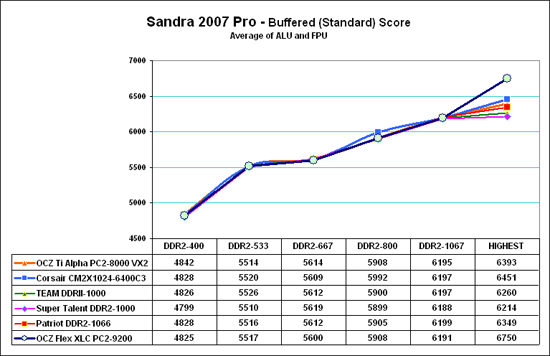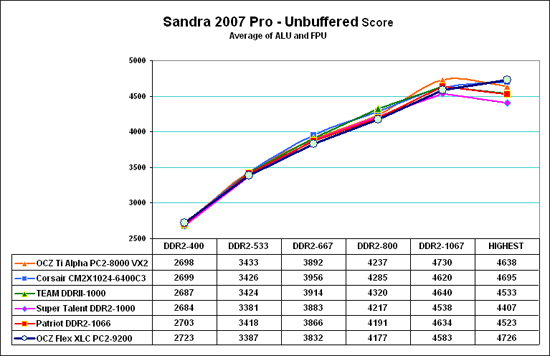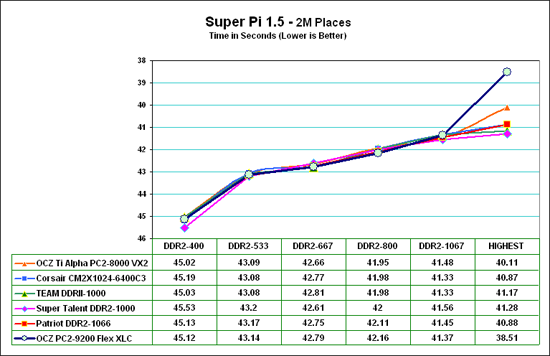OCZ Flex XLC: PC2-9200 Pushes the Envelope
by Wesley Fink on December 8, 2006 8:00 PM EST- Posted in
- Memory
Memory Bandwidth Scaling
Memory bandwidth normally improves with increases in memory speed and reductions in memory timings. This is best illustrated using Performance Scaling charts instead of Bar charts for individual speeds.
Since the results for high-end memory are so close at all tested speeds, the scale range was reduced to better show the small differences in these memory benchmark results. Please keep this in mind when viewing the charts, since a normal zero scale would make performance differences appear much smaller than these expanded scale charts. Values for the tested DIMMs at each speed are included below each chart for reference.
To evaluate memory bandwidth SiSoft Sandra 2007 Professional was used to provide a closer look at scaling for fast DDR2 memory.

The most widely reported Sandra score is the Standard or Buffered memory score. This benchmark takes into account the buffering schemes like MMX, SSE, SSE2, SSE3, and other buffering tools that are used to improve memory performance. The Buffered benchmark does not correlate well with real performance differences in games, so our memory bandwidth tests have always included an Unbuffered Sandra memory score. The Unbuffered result turns off the buffering schemes, and we have found the differences in Unbuffered results correlate well with real-world performance differences.

In both Buffered and Unbuffered tests we see the OCZ Flex XLC mirrors the best memory tested to DDR2-1066. This is exactly what would be expected since the Flex XLC is based on the same core memory chip as the other tested memories. Memory bandwidth increases dramatically at the top in buffered bandwidth (standard test). This is mostly a result of the much higher overclock in memory that could be achieved with the OCZ PC2-9200 Flex XLC compared to other Micron D-based memory. Unbuffered results also increase at the top speed, but not as dramatically as buffered results. This is also the expected result.
A look back at the page 4 tables will show that where we tested with the same CPU speed at the highest memory overclock the bandwidth increases at DDR2-1192 are smaller. The bandwidth increases at the default 2.93 GHz speed are strictly the result of increased memory speed, as CPU speed is eliminated as a variable.
We also compared results with Version 1.5 of Super Pi - comparing the time to calculate 2 million places of Pi at the different memory speeds. This benchmark measures pure number crunching.

Super Pi results continue to improve all the way to the highest speed that could be reached with stability with each memory. The second result that stands out is how close the results with all the memories really are from DDR2-400 to DDR2-1066. This is mainly a reflection of the fact that compared memories are based on the same base Micron memory chips. At the highest speed Flex XLC pulls away from the pack with the record DDR2-1172 overclock. However, the 1172 top speed at stock 2.93 GHz is very close to DDR2-1067 results. These two results show the impact of CPU speed on calculation performance is much greater than the impact of memory speed increases.
Memory bandwidth normally improves with increases in memory speed and reductions in memory timings. This is best illustrated using Performance Scaling charts instead of Bar charts for individual speeds.
Since the results for high-end memory are so close at all tested speeds, the scale range was reduced to better show the small differences in these memory benchmark results. Please keep this in mind when viewing the charts, since a normal zero scale would make performance differences appear much smaller than these expanded scale charts. Values for the tested DIMMs at each speed are included below each chart for reference.
To evaluate memory bandwidth SiSoft Sandra 2007 Professional was used to provide a closer look at scaling for fast DDR2 memory.

The most widely reported Sandra score is the Standard or Buffered memory score. This benchmark takes into account the buffering schemes like MMX, SSE, SSE2, SSE3, and other buffering tools that are used to improve memory performance. The Buffered benchmark does not correlate well with real performance differences in games, so our memory bandwidth tests have always included an Unbuffered Sandra memory score. The Unbuffered result turns off the buffering schemes, and we have found the differences in Unbuffered results correlate well with real-world performance differences.

In both Buffered and Unbuffered tests we see the OCZ Flex XLC mirrors the best memory tested to DDR2-1066. This is exactly what would be expected since the Flex XLC is based on the same core memory chip as the other tested memories. Memory bandwidth increases dramatically at the top in buffered bandwidth (standard test). This is mostly a result of the much higher overclock in memory that could be achieved with the OCZ PC2-9200 Flex XLC compared to other Micron D-based memory. Unbuffered results also increase at the top speed, but not as dramatically as buffered results. This is also the expected result.
A look back at the page 4 tables will show that where we tested with the same CPU speed at the highest memory overclock the bandwidth increases at DDR2-1192 are smaller. The bandwidth increases at the default 2.93 GHz speed are strictly the result of increased memory speed, as CPU speed is eliminated as a variable.
We also compared results with Version 1.5 of Super Pi - comparing the time to calculate 2 million places of Pi at the different memory speeds. This benchmark measures pure number crunching.

Super Pi results continue to improve all the way to the highest speed that could be reached with stability with each memory. The second result that stands out is how close the results with all the memories really are from DDR2-400 to DDR2-1066. This is mainly a reflection of the fact that compared memories are based on the same base Micron memory chips. At the highest speed Flex XLC pulls away from the pack with the record DDR2-1172 overclock. However, the 1172 top speed at stock 2.93 GHz is very close to DDR2-1067 results. These two results show the impact of CPU speed on calculation performance is much greater than the impact of memory speed increases.










29 Comments
View All Comments
yyrkoon - Saturday, December 9, 2006 - link
There is no "for shits and giggles" about it, it would help. How much it would actually help would be open for debate (until someone actually tested it).For one, it would help, because, IF you for example had air coming in from the bottom, and air exiting out through the top, you would be using convection to recycle cooler air from the outside, and the heat would travel out through the top. To some small degree, you wouldn't even need a pump to accomplish this. This would also keep hot air from recycling, well, at least concerning *from* the memory(to a small degree) , which wouldn't mean a whole lot.
Now, if instead of using convection, you use forced air, whether chilled or not, dependent on the CFM pushed through, you *could* reduce the temperature on the heat spreaders drastically. This may not cool as well as water, but there would be no chance of water leakage either, and would result in a definite improvement. Granted, I can not see people wanting to go out an buy a <insert brand here> air compressor, for what whatever amount, when it would be cheaper to go water(which, its self, isn't cheap either). I've priced components for a good water cooling system, and we're talking around $400 usd, for a decent setup, which IMO, would be better just spending the extra cash on a better/faster CPU(if possible). Less problems, and hassle.
Never seen a Dell that uses a plastic "funnel" over the CPU, without a CPU fan directly over the CPU? They exist, and they do very well in keeping the system very cool. Same concept, on a smaller scale.
Larso - Monday, December 11, 2006 - link
Though the idea is interesting, I think you would be better off pushing air over the cooling fins the usual way, than to push air through the water cooling intake. Remember that air and water have very different properties and the cooling interfaces has been designed to optimize each of those elements.It could be an interesting experiment I must admit, but I suspect you would get just get a lot of hissing noise from the end of the hose - and not a lot of cooling...
cruzer - Saturday, December 9, 2006 - link
If you pumped cold air in through the block, you will get condensation in the lines.PrinceGaz - Saturday, December 9, 2006 - link
Erm, no you wouldn't. Condensation only forms when the air is cooled down by something, such as on a cold window in a warm room, because cooler air is unable to hold as much moisture as warm air so excess moisture has to be dumped as condensation when the relative humidity reaches 100%.Pumping cold air through the block carries no risk of condensation because the air will be warmed rather than cooled. In fact it would be an effective way of removing any moisture because the air warmed by the block would have a fairly low relative humidity.
yyrkoon - Friday, December 8, 2006 - link
Hell, I'd even venture to say that if you forced room temperature air through these fast enough, even on a warm day, the results would be great. Granted, you would have to be strategic about it.Frumious1 - Friday, December 8, 2006 - link
I realize you don't normally test water cooling (or cooling products in general), but it seems one of the major points for this RAM is that it is ready to be used with water cooling. Rather than speculating about if it will help or not, how about actually testing it? Seems like this RAM would be great for people looking to build a silent system, as you now don't have to worry about the RAM overheating either with water cooling.Also, this wasn't mentioned in the article, but can you fit two DIMMs next to each other? Meaning, could you go all the way to four DIMMs? Reason I ask is that if you can't then there are going to be some boards where this RAM won't work at all in dual channel mode. Hopefully OCZ wasn't so shortsighted as to make the DIMMs take more than a single slot width, but at the same time I don't know how you get effective water cooling without the HSF getting quite a bit thicker than the typical heatspreader.
Wesley Fink - Friday, December 8, 2006 - link
We should have mentioned that the OCZ Flex XLC is thin enough that 4 dimms can be fitted in standard memory slots. We tried side by side slots in a number of boards and the dimms fit fine side-by-side.We considered testing with water also, but we did not have the correct fittings available, it would have taken a while to get the fittings we needed, and we wanted to get the info to our readers as fast as possible. OCZ emphasizes the Flex nature of the memory, and we thought you would want to know about the outstanding performance on air with Flex XLC.
Perhaps we will relent and test with water in a future review, but we're not completely sure we want to go in that direction. We generally find we can overclock using air cooling at speeds similar to some other sites who insist you can only cool with water.
The "silent" aspect is a good argument for water cooling, but most water systems still have a fan to cool the liquid and a pump for recirculating the fluid. Some water cooling systems are therefore about as "noisy" as a good air-cooled system - though we do agree that many water cooling systems are very quiet.
brownba - Friday, December 8, 2006 - link
no doubt the water cooled feature should have been tested.I'm also wondering how the heatsink is designed - does the water flow down the front of the stick over the actual memory chips?
Hypernova - Friday, December 8, 2006 - link
If you look at the last page on the "Pre-CES Taiwan 2006, Day 1" article that's exactly what they had in there.